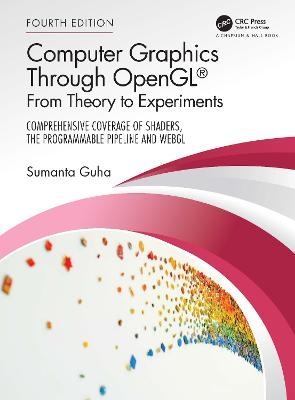
Computer Graphics Through OpenGL®
Chapman & Hall/CRC (Verlag)
978-1-032-25698-6 (ISBN)
From geometric primitives to animation to 3D modeling to lighting, shading and texturing, Computer Graphics Through OpenGL®: From Theory to Experiments is a comprehensive introduction to computer graphics which uses an active learning style to teach key concepts. Equally emphasizing theory and practice, the book provides an understanding not only of the principles of 3D computer graphics, but also the use of the OpenGL® Application Programming Interface (API) to code 3D scenes and animation, including games and movies.
The undergraduate core of the book takes the student from zero knowledge of computer graphics to a mastery of the fundamental concepts with the ability to code applications using fourth-generation OpenGL®, as well as using WebGL® in order to publish to the web. The remaining chapters explore more advanced topics, including the structure of curves and surfaces, applications of projective spaces and transformations and the implementation of graphics pipelines.
This book can be used for introductory undergraduate computer graphics courses over one to two semesters. The careful exposition style attempting to explain each concept in the simplest terms possible should appeal to the self-study student as well.
Features
Covers the foundations of 3D computer graphics, including animation, visual techniques and 3D modeling
Comprehensive coverage of OpenGL® 4.x, including the GLSL and vertex, fragment, tessellation and geometry shaders
Comprehensive coverage of WebGL® 2.0.
Includes 440 programs and experiments
Contains 700 exercises, 100 worked examples and 650 four-color illustrations
Requires no previous knowledge of computer graphics
Balances theory with programming practice using a hands-on interactive approach to explain the underlying concepts
Sumanta Guha earned a Ph.D. in mathematics from the Indian Statistical Institute, Kolkata, in 1987. From 1984 to 1987 he taught mathematics at Jadavpur University in Kolkata. He left in 1987 to study computer science at the University of Michigan in Ann Arbor, where he earned a Ph.D. in 1991. On graduating from Michigan he joined the Electrical Engineering and Computer Science faculty of the University of Wisconsin-Milwaukee where he taught from 1991 to 2002. In 2002 he moved to the Computer Science and Information Management program of the Asian Institute of Technology in Thailand, where he taught till 2019. Since then he has been working independently on projects of his own. Sumanta's research interests include computational geometry, computer graphics, computational topology, robotics and data mining.
I. Hello World 1. An Invitation To Computer Graphics 2 .On To OpenGL And 3D Computer Graphics II. Tricks Of The Trade 3. An OpenGL Toolbox III. Movers And Shapers 4. Transformation, Animation And Viewing 5. Inside Animation: The Theory of Transformations 6. Advanced Animation Techniques IV. Geometry for the Home Office 7. Convexity and Interpolation 8. Triangulation 9. Orientation V. Making Things Up 10. Modeling in 3D Space VI. Lights, Camera, Equation 11. Color and Light 12. Texture 13. Special Visual Techniques VII. Pixels, Pixels, Everywhere 14. Raster Algorithms VIII. Programming Pipe Dreams 15. OpenGL 4.3, Shaders And The Programmable Pipeline: Liftoff 16. OpenGL 4.3, Shaders And The Programmable Pipeline: Escape Velocity IX. A Shader's Web 17. WEBGL X. Anatomy of Curves and Surfaces 18. Bézier XI. Well Projected 19. Applications Of Projective Spaces: Projection Transformations and Rational Curves XII. Time For A Pipe 20. Pipeline Operation Appendices A. Math Self-test B. Math Self-test Solutions Bibliography Subject Index Program Index
| Erscheinungsdatum | 28.11.2022 |
|---|---|
| Zusatzinfo | 11 Tables, color; 957 Halftones, black and white; 957 Illustrations, color |
| Sprache | englisch |
| Maße | 210 x 280 mm |
| Gewicht | 2280 g |
| Themenwelt | Kunst / Musik / Theater |
| Mathematik / Informatik ► Informatik ► Grafik / Design | |
| Mathematik / Informatik ► Informatik ► Programmiersprachen / -werkzeuge | |
| Informatik ► Software Entwicklung ► User Interfaces (HCI) | |
| ISBN-10 | 1-032-25698-2 / 1032256982 |
| ISBN-13 | 978-1-032-25698-6 / 9781032256986 |
| Zustand | Neuware |
| Informationen gemäß Produktsicherheitsverordnung (GPSR) | |
| Haben Sie eine Frage zum Produkt? |
aus dem Bereich


